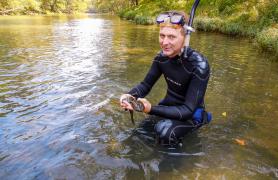The chorus starts just after sundown. As the moon rises and night creeps in, a lonely howl wavers through the gloom. And when one coyote (kie-oh-tee or kie-oht) starts raising a ruckus, nearby coyotes usually join in.
Although it sounds spooky, there’s nothing to fear. Howling is how coyotes talk to each other. A coyote might howl to say, “I’m lonely,” “Stay away,” or “Let’s find some rabbits to eat.”
They have quite a vocabulary, too. In addition to howling, coyotes bark, yip, yelp, whimper, and growl. And the racket they make can be heard more than 3 miles away on a clear, calm night.
Country Dog, City Dog
Before the United States became a country, coyotes lived only on the plains and prairies of the Wild West. But in the 1800s, people started moving out of bustling eastern cities and into the less-crowded countryside. As settlers carved habitat into farms and ranches, they got rid of wolves and mountain lions. When the big predators moved out, crafty coyotes crept in.
Today, coyotes howl from coast to coast across America, north into Canada, and south into Central America. They hunt for food and raise their families in forests, farmland, prairies, and deserts. And they even live in cities like Kansas City and St. Louis. In fact, biologists estimate that more than 2,000 coyotes live in Chicago, the third largest city in America.
Furry Einsteins
One reason coyotes can survive nearly anywhere is because they’re super smart. The cunning canines often follow circling crows and vultures to find dead animals for dinner. They slink around the edges of fields while farmers cut hay, hoping to intercept rabbits and rodents fleeing from the mower. And they’ve even been known to team up with badgers to bag snacks, which spells double the trouble for tunnel-dwelling prey. If a ground squirrel hunkers down in its home, the burly badger digs it up for dinner. But if the squirrel scurries out of its burrow, the crafty coyote is waiting to snap it up.
Hungry Hunters
Coyotes aren’t picky about what they stuff in their pie-holes. Rabbits and mice make up most of the menu, but the predatory pooches will eat whatever they can catch, including squirrels, deer, birds, carrion (already dead animals), fruits, pet food, and even human garbage.
Unlike wolves, which hunt together in packs, coyotes usually hunt alone. To catch small prey, a coyote sneaks up as close as it can, freezes in place for a moment or two, and then — SPROING! — leaps high in the air so it can pounce on the unsuspecting snack with all four paws.
Doggone Fast
To escape danger or run down fleetfooted prey, a coyote can scurry in a hurry. Missouri’s fastest land animal can sprint short distances at a blistering 45 mph. That’s doggone fast! Compared to coyotes, people are at the back of the pack. The fastest human sprinters can reach speeds of only 27 mph.
New Digs
For most of the year, coyotes simply sleep on the ground in a hidden, protected spot. But in the spring, coyote couples search for a den. Sometimes they remodel a burrow that was once owned by a fox, woodchuck, or badger. Other times, they dig their own den in loose soil. The home-sweet-holes are often in a bank, under a hollow log, or beneath a deserted building. Wherever it’s located, the den will soon become a lot more crowded.
Pack of Pups
In late April or May, a mama coyote settles inside the den to have her babies. She usually gives birth to about six puppies, but some super moms may have more than a dozen little howlers. Raising babies is hard work! The newborn pups are blind and helpless. Mom feeds them milk and licks them clean. Dad doubles up on hunting duty, bringing home extra food so mom doesn’t get hungry.
Puppy Chow
In about two weeks, the pups’ eyes blink open, and they begin to wander around their den. When they’re 5 or 6 weeks old, they start to explore outside ofthe nursery. If a pup strays too far from home, one of the parents picks it up gently with its teeth and carries it back to safety.
When the pups quit drinking milk, they start eating “puppy chow.” This is meat that mom and pop chew up and spit out for the pups to eat. In between feedings, the rowdy youngsters wrestle with each other and play tug-of-war with bones and sticks.
When the pups are 2 or 3 months old, they join their parents on hunting trips. At first, they watch mom and pop catch prey, but soon they join in the effort. By late summer, the pups can fend for themselves, and by fall, they’re well on their way to being yappy, snappy, wily coyotes.












Also In This Issue

This Issue's Staff
Les Fortenberry
Angie Daly Morfeld
Noppadol Paothong
Marci Porter
Mark Raithel
Laura Scheuler
Matt Seek
David Stonner
Stephanie Thurber
Cliff White






















